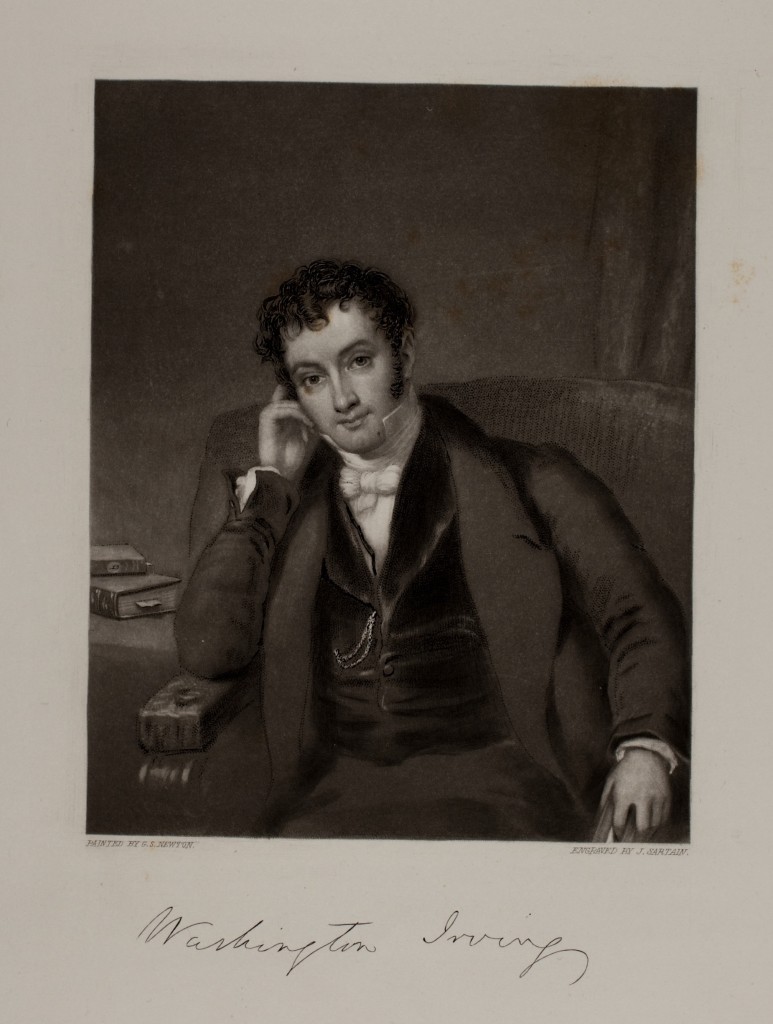
What comes to mind when you hear “Sleepy Hollow”? A dark, windy night, a mysterious horseman who just happens to have no head, a terrified Ichabod Crane fleeing for his life—no matter in what form you first come to know “The Legend of Sleepy Hollow,” there are certain dramatic elements the story always seems to have in common.
Two recent screen adaptations take very different approaches (neither even close to the original material), but retain these basic features. The 1999 horror-thriller-mystery Sleepy Hollow, which pairs the gothic vision of Tim Burton with the talents of Johnny Depp and Christina Ricci, takes place in roughly the same time period as the original tale, but makes Ichabod (Depp) a constable rather than a schoolmaster, the Headless Horseman murders half a dozen people, and Ichabod marries Katrina (Ricci). FOX’s current TV show by the same name grafts the gothic onto a pseudo-historical/biblical frame, reimagining Ichabod as an English-born Revolutionary War patriot who, put into a magical sleep by Katrina (now a witch, of course), awakes in modern times to find out that he must stop the Headless Horseman, who is both Abraham (Brom Bones) and the Horseman of Death from the Book of Revelation. (Interestingly, for all the differences between how the two adaptations depart from the source material, both associate Ichabod with law enforcement and test his crime-solving skills in a procedural drama format.)
Mulling over these two recent interpretations of the classic tale while working at AAS inevitably raises the question, what did early depictions of the story look like? Were they also gothic and horror-inspired? Did they focus on the terrifying imagery of the Headless Horseman? Was Ichabod as attractive as Johnny Depp or Tom Mison?
Washington Irving first published the story as part of a compendium of short stories and essays called The Sketch Book of Geoffrey Crayon, Gent. Published in seven serial parts over the course of 1819 and 1820 in both the U.S. and England, The Sketch Book is widely considered to be one of the first pieces of American literature read extensively abroad. The publishing history of the many ensuing editions of The Sketch Book is long and complex, but suffice it to say that by 1848, when famed New York publisher George Putnam published the first illustrated edition of The Sketch Book, “The Legend of Sleepy Hollow” was indeed already that—a legend.
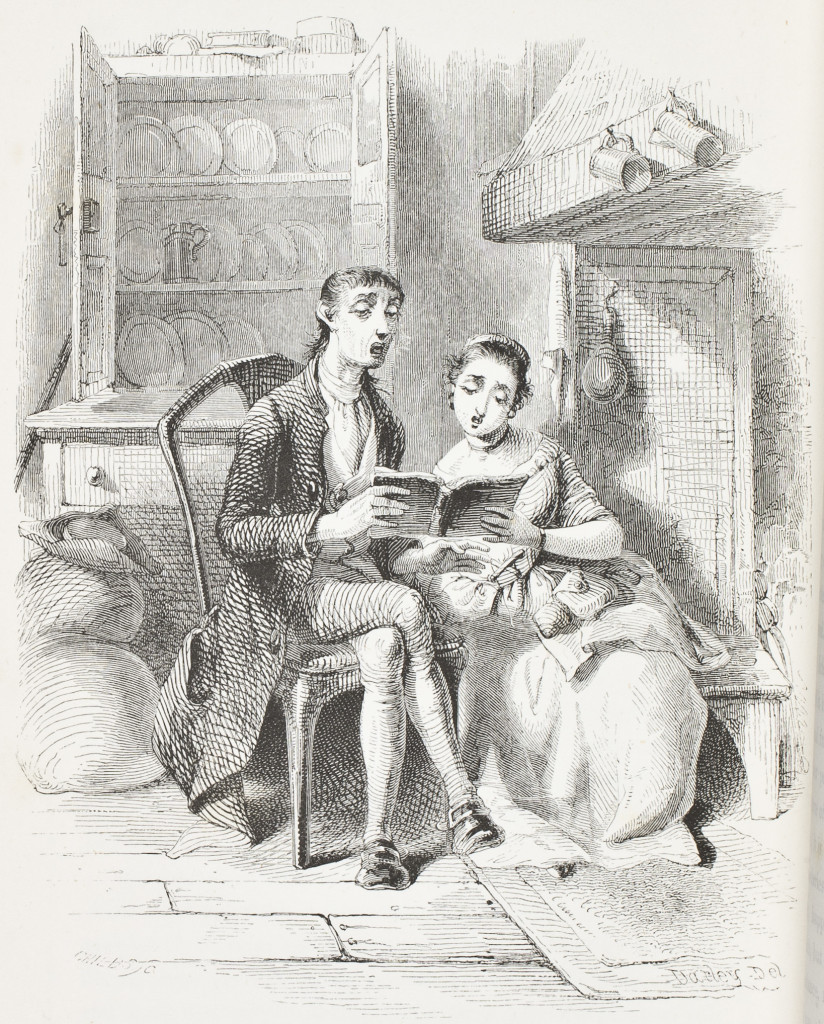 This first illustrated edition featured the work of Felix O. C. Darley, a self-taught artist and book illustrator who had already done work for Edgar Allan Poe and Harper’s Weekly, among others, by the time he was tapped to take on some of Irving’s most famous stories. Ultimately, he would become one of the most prolific and renowned book illustrators of his day, creating accompaniments for works by Nathaniel Hawthorne, Harriet Beecher Stowe, and James Fenimore Cooper. (We recently launched an online exhibition about J. F. Cooper material at AAS, including an entire section with digital copies of Darley’s illustrations!)
This first illustrated edition featured the work of Felix O. C. Darley, a self-taught artist and book illustrator who had already done work for Edgar Allan Poe and Harper’s Weekly, among others, by the time he was tapped to take on some of Irving’s most famous stories. Ultimately, he would become one of the most prolific and renowned book illustrators of his day, creating accompaniments for works by Nathaniel Hawthorne, Harriet Beecher Stowe, and James Fenimore Cooper. (We recently launched an online exhibition about J. F. Cooper material at AAS, including an entire section with digital copies of Darley’s illustrations!)
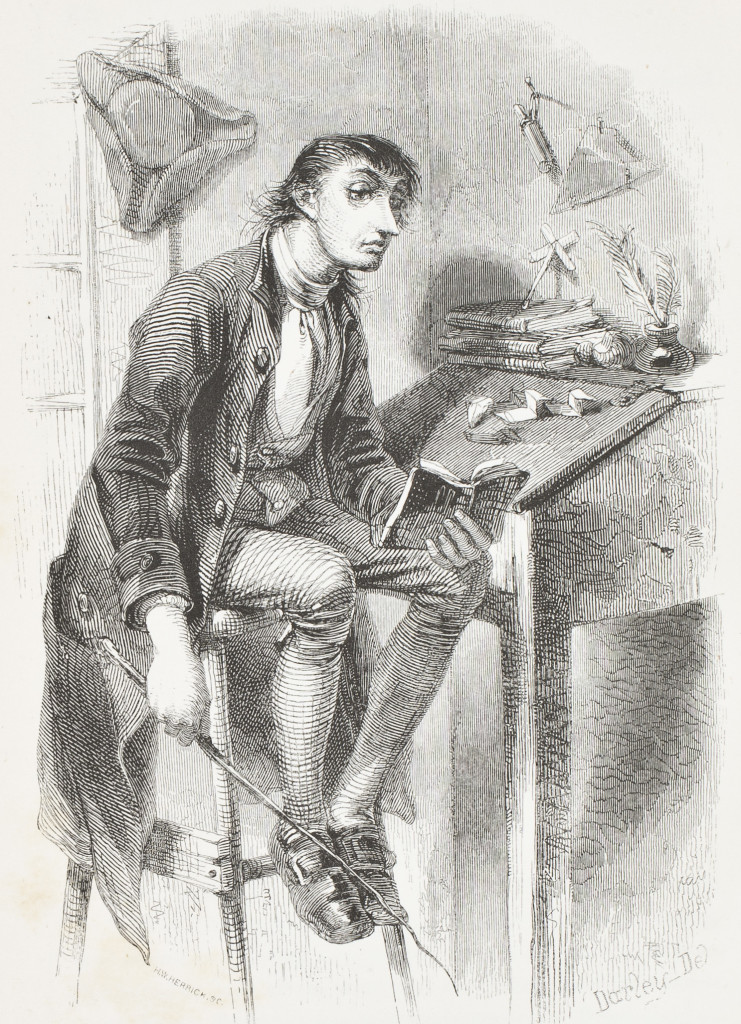 Despite the success of this first illustrated edition of The Sketch Book, from a modern perspective the images for “Sleepy Hollow” are almost a bit disappointing. Since Darley illustrated the entire volume, “Sleepy Hollow” gets just two illustrations, neither of which include the Horseman. The first shows Ichabod giving singing lessons to Katrina, and the second depicts Ichabod at his schoolmaster’s desk (accompanied by a few origami cranes embodying his name). Although the subject matter of the illustrations is less than thrilling, Darley’s depictions of Ichabod and Katrina closely follow Irving’s descriptions. Ichabod, who is described as “tall, but exceedingly lank, with narrow shoulders, long arms and legs, hands that dangled a mile out of his sleeves, feet that might have served for shovels, and his whole frame most loosely hung together,” is gaunt, lanky, and grotesque—certainly lacking the refinement of Depp or Mison’s modern Ichabods. Meanwhile, Katrina, that “blooming lass of fresh eighteen; plump as a partridge; ripe and melting and rosy-cheeked as one of her father’s peaches,” is all buxom femininity.
Despite the success of this first illustrated edition of The Sketch Book, from a modern perspective the images for “Sleepy Hollow” are almost a bit disappointing. Since Darley illustrated the entire volume, “Sleepy Hollow” gets just two illustrations, neither of which include the Horseman. The first shows Ichabod giving singing lessons to Katrina, and the second depicts Ichabod at his schoolmaster’s desk (accompanied by a few origami cranes embodying his name). Although the subject matter of the illustrations is less than thrilling, Darley’s depictions of Ichabod and Katrina closely follow Irving’s descriptions. Ichabod, who is described as “tall, but exceedingly lank, with narrow shoulders, long arms and legs, hands that dangled a mile out of his sleeves, feet that might have served for shovels, and his whole frame most loosely hung together,” is gaunt, lanky, and grotesque—certainly lacking the refinement of Depp or Mison’s modern Ichabods. Meanwhile, Katrina, that “blooming lass of fresh eighteen; plump as a partridge; ripe and melting and rosy-cheeked as one of her father’s peaches,” is all buxom femininity.
But these were not the only illustrations Darley made for “Sleepy Hollow” around this time. In 1850, the American Art-Union released a folio edition of the story for its members, which featured six beautiful outline lithographs by Darley, none of which were the same illustrations as the two in The Sketch Book. And although these depictions are more illustrative of the actual story—here we see Ichabod with his pupils and at the Van Tassel party and being chased by the Horseman—Ichabod, though still a bit ragged and ungainly, has become somewhat less ludicrous-looking, and thanks to the busily peopled scenes and slightly less exaggerated faces, the overall feel is more storybook than gothic.
This is also where a depiction of the Headless Horseman first appears. In fact, there are two (see below): In the first, when Ichabod initially sees him, the Horseman clearly has a head covered by a hood, but a round shape (the pumpkin) also sits in front of him on the horse. In the second, as he’s chasing Ichabod, he appears to be indeed headless, and the pumpkin is still nestled in front of him. Perhaps this was Darley’s way of demonstrating the power of fear and darkness to turn the illusion into a reality.
In 1864, Putnam issued a new illustrated edition of the full Sketch Book, featuring the work of several different artists, including William Hart and John Frederick Kensett of the Hudson River School and Emanuel Leutze, most famous for Washington Crossing the Delaware. In order to get as much mileage as possible out of this new edition, Putnam also released Hudson Legends as a separate volume, which included only “Sleepy Hollow” and “Rip Van Winkle.”

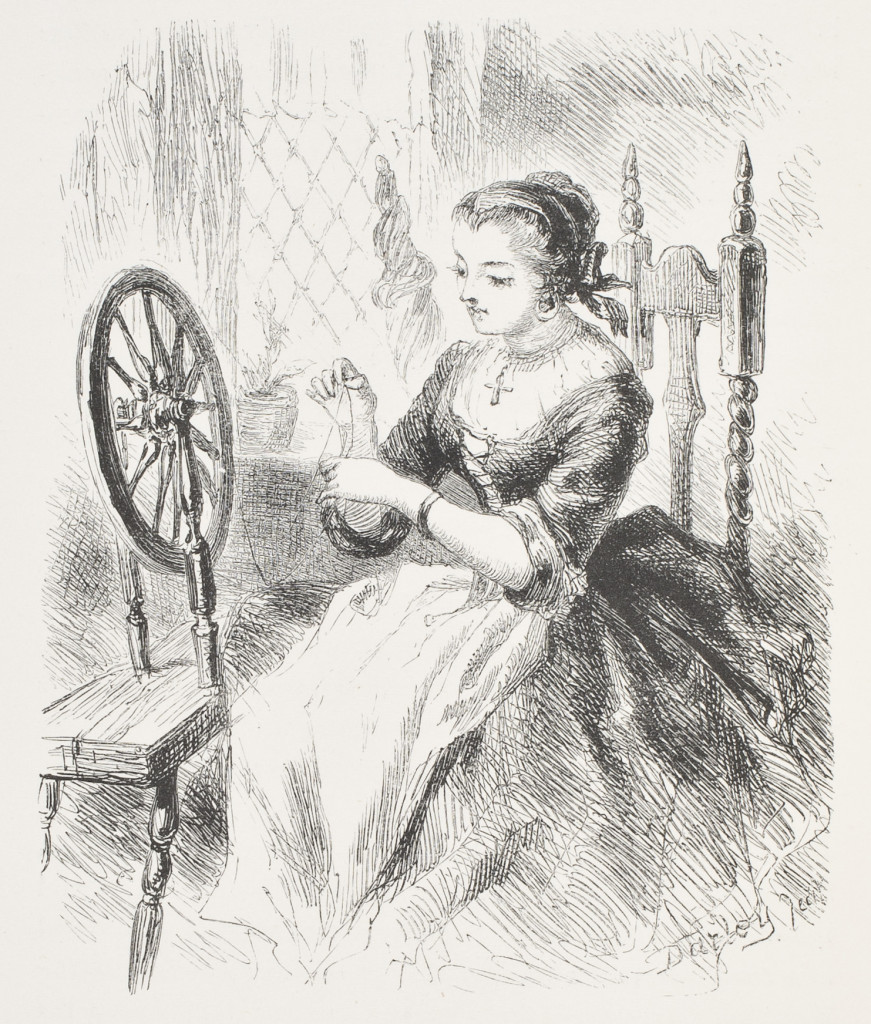 Two of the illustrations in this new version of “Sleepy Hollow” were by Darley, both of Katrina, looking very similar to his version of her in the lithographs for the 1850 Art Union book. One of them places her at spinning wheel, emphasizing her female usefulness, as well as her beauty. The other illustrations included several landscapes, such as the Tappan Zee and the Sleepy Hollow Church (the latter done by Hart), a scene of Katrina and Ichabod together, and of course the Horseman’s chase.
Two of the illustrations in this new version of “Sleepy Hollow” were by Darley, both of Katrina, looking very similar to his version of her in the lithographs for the 1850 Art Union book. One of them places her at spinning wheel, emphasizing her female usefulness, as well as her beauty. The other illustrations included several landscapes, such as the Tappan Zee and the Sleepy Hollow Church (the latter done by Hart), a scene of Katrina and Ichabod together, and of course the Horseman’s chase.

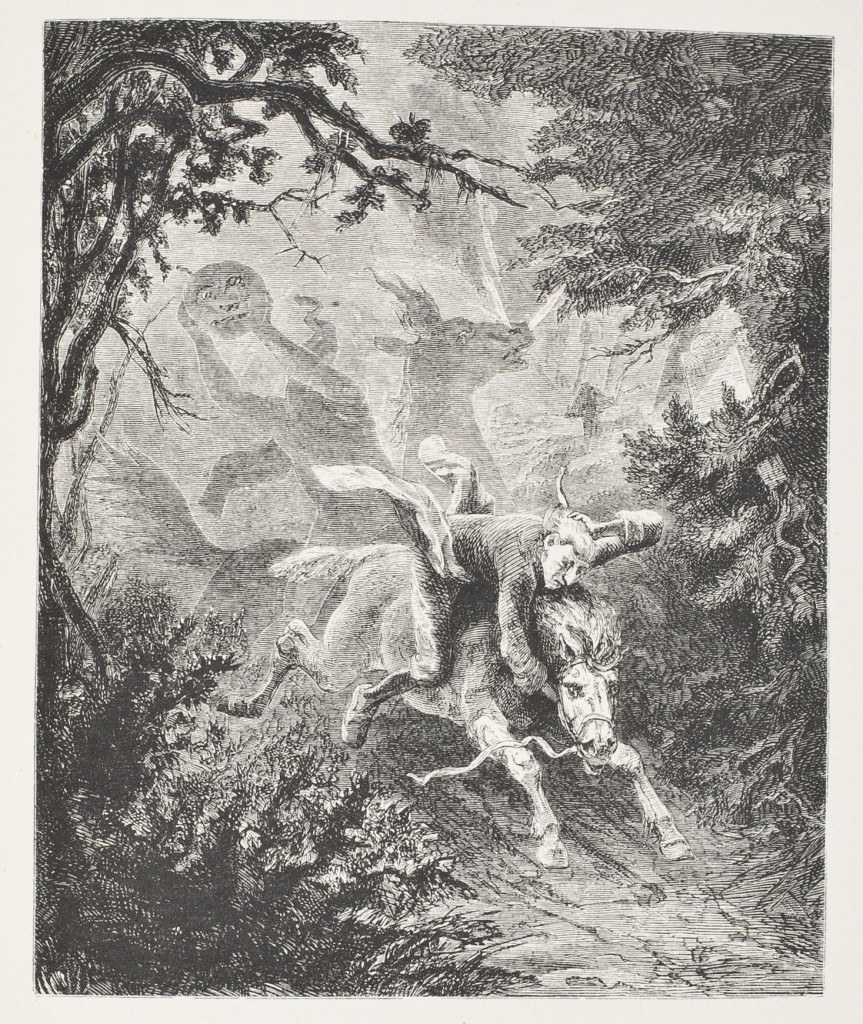 This last image, done by Leutze and titled “Ichabod and Brom Bones,” eliminates the implication from Irving’s telling by outright naming the Horseman. Like Darley’s depiction of the scene, a clumsy Ichabod flees the Horseman, but in this version the Horseman wields a giant pumpkin with a carved face. The added depth of shading and the framing of the trees in this version, as well as the visible pumpkin face, emphasize the spooky atmosphere. We know Leutze is good at setting tone given the iconic Washington Crossing the Delaware, but it feels a bit strange to see that same skill applied to illustrating a gothic folktale, albeit one that was an icon in itself.
This last image, done by Leutze and titled “Ichabod and Brom Bones,” eliminates the implication from Irving’s telling by outright naming the Horseman. Like Darley’s depiction of the scene, a clumsy Ichabod flees the Horseman, but in this version the Horseman wields a giant pumpkin with a carved face. The added depth of shading and the framing of the trees in this version, as well as the visible pumpkin face, emphasize the spooky atmosphere. We know Leutze is good at setting tone given the iconic Washington Crossing the Delaware, but it feels a bit strange to see that same skill applied to illustrating a gothic folktale, albeit one that was an icon in itself.
 From this point on, “The Legend of Sleepy Hollow” saw innumerable reprints and new illustrated editions, each generation putting its own stamp on the story’s imagery. One 1906 edition in our collections, for example, relies heavily on shades of orange, brown, and black to set an eerie atmosphere—reminiscent of colors associated with dime novels—and its depiction of the chase is truly terrifying. The horseman carries not a pumpkin, but instead swings an actual head by its ponytail. Clearly the publisher cared less about accurately illustrating the story and more about provoking fear and horror in its audience.
From this point on, “The Legend of Sleepy Hollow” saw innumerable reprints and new illustrated editions, each generation putting its own stamp on the story’s imagery. One 1906 edition in our collections, for example, relies heavily on shades of orange, brown, and black to set an eerie atmosphere—reminiscent of colors associated with dime novels—and its depiction of the chase is truly terrifying. The horseman carries not a pumpkin, but instead swings an actual head by its ponytail. Clearly the publisher cared less about accurately illustrating the story and more about provoking fear and horror in its audience.
Once film adaptations were possible, the imagery of “The Legend of Sleepy Hollow” changed continuously and departed even further from the story, whether through a silent film, or cartoon dogs and frogs, or live-action movies, all spanning over ninety years. In 1974, the story was even immortalized on a postal stamp. For my part, I don’t much mind what form the legend takes, as long as it lives on.

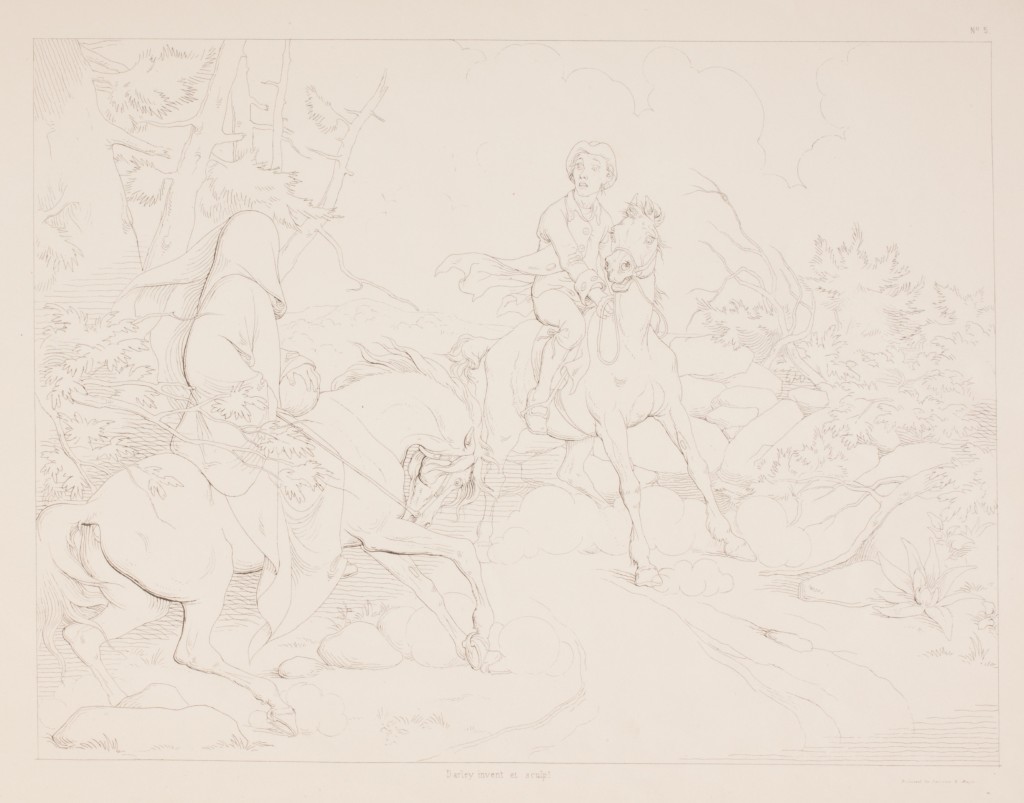
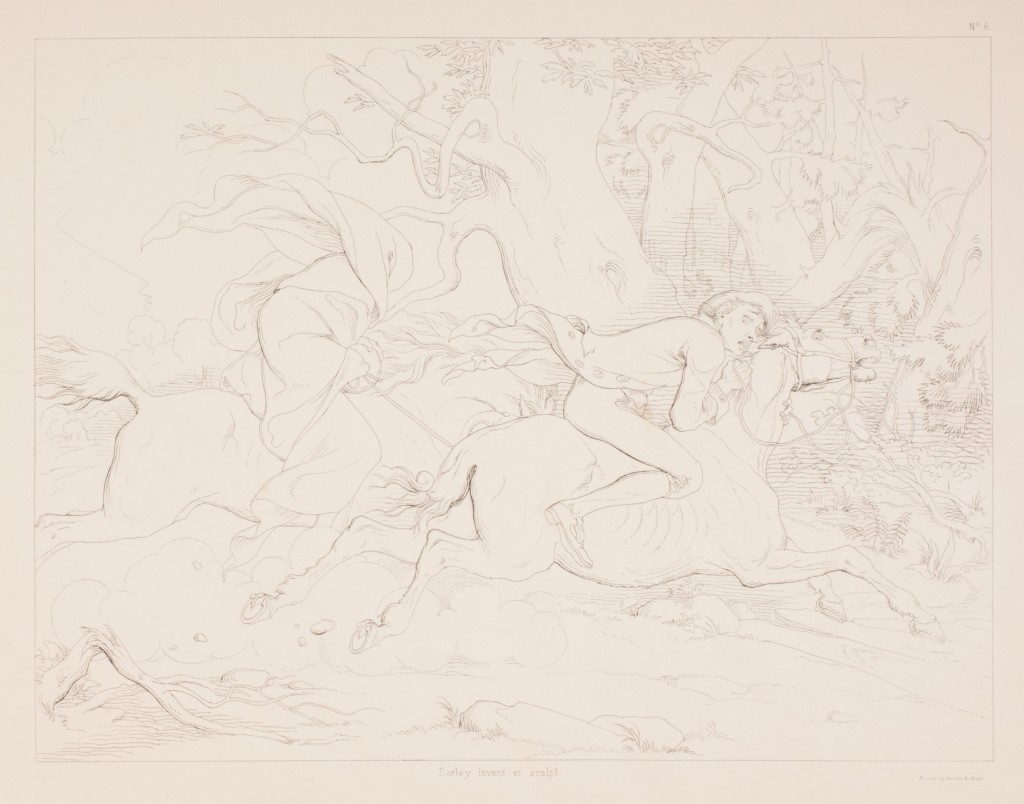
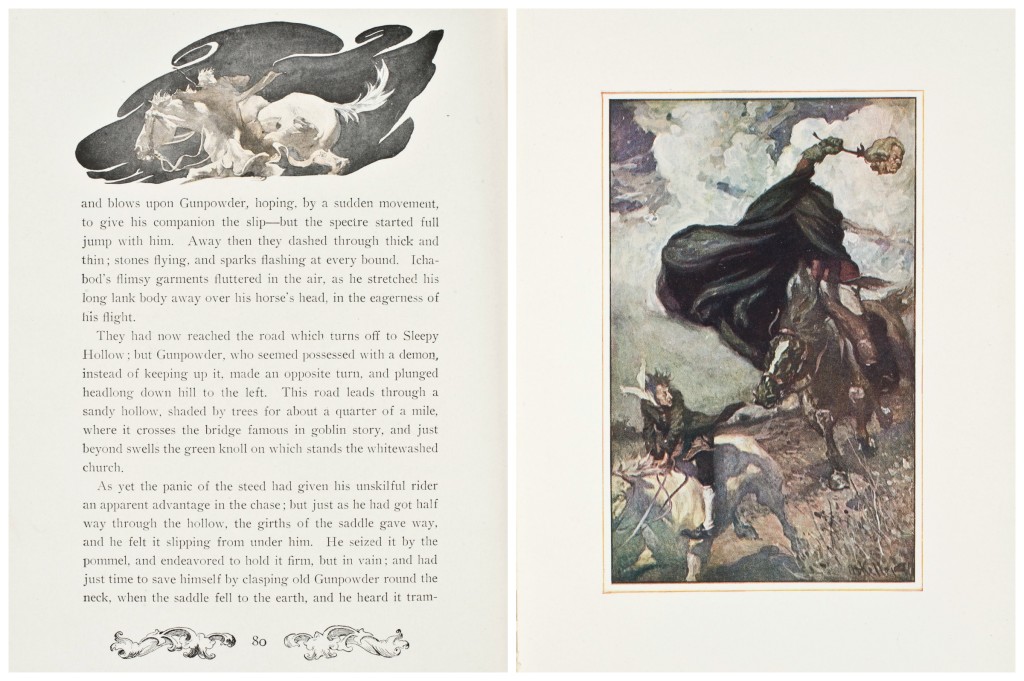
One thought on “The Many Faces of the Headless Horseman: Illustrations of “The Legend of Sleepy Hollow””